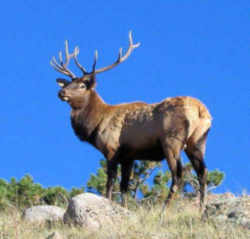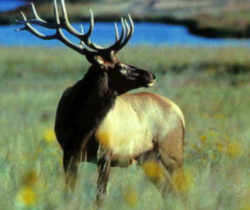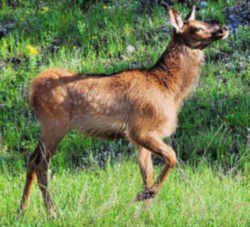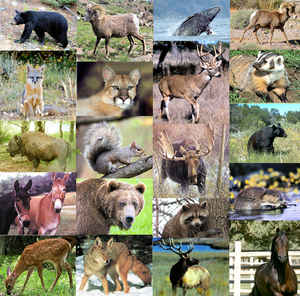
Utah Symbols
Utah State Animal
Rocky Mountain Elk

(Cervus canadensis)
Adopted on February 1, 1971 .
The Rocky Mountain Elk, (Cervus canadensis,) was adopted on February 1, 1971.
According to the Ogden Standard-Examiner, Senate Bill No. 18, designating an official state animal, and Senate Bill No. 19, designating an official state fish, were the first bills of the 1971 legislative session to reach Governor Calvin L. Rampton's desk for approval. Introduced by State Senator Kendrick Harward on January 11, 1971, both bills were proposed by, and obviously well escorted through the legislature by, elementary school students from Richmond and were approved by the State Senate and the House and signed by the governor in less than one month!
The elk became the official animal and the rainbow trout became the official state fish of the State of Utah when Governor Rampton signed Senate Bill No. 18 and Senate Bill No. 19 on February 1, 1971.
Sometimes called wapiti by the Shawnee Indians and the scientists of later times, the American Elk was first named by early English colonists. They were once found over most of the United States and southern Canada, but hunters have killed so many of them that they survive only in regions west of the Rocky Mountains. The largest herds live in Yellowstone Park, on Montana's Sun River, and in Washington's Olympic Mountains. They are also plentiful on most mountain ranges in Utah.
Utah State Animal: Rocky Mountain Elk

A member of the deer family, the elk lives in close association with the deer and moose throughout much of Utah. Only the male elk carry antlers. They can spread more than 5 feet. Antlers grow during the summer and are shed in the late winter. The cows (female elk) are smaller than the male and do not have antlers. Mature bulls stand up to 60 inches at the shoulder and may weigh over 700 pounds.
They usually eat the grasses. they also eat the twigs and needles of fir, juniper, and trees and shrubs during a harsh winter.
Wolves and cougars are among the natural enemies of elk, as well as bear and coyotes that look for calves and sick animals.
Characteristics of the Rocky Mountain Elk

Elks range in color from dark brown in winter to tan in summer and have a characteristic buff colored rump. The head, neck, belly and legs are darker than both the back and sides. Elk generally have a long head with large ears and widely branching antlers as long as 1.1-1.5 m from tip to tip. A dark shaggy mane hangs from the neck to the chest. With a thick body, short tail and long slender legs, most elk stand approximately 0.75-1.5 m high at the shoulder and are 1.6-2.7 m from nose to tail. Most males are 10 percent larger than females and weigh twice as much. Mass: 230 to 450 kg.
Geographic Range
Palearctic, Nearctic: Although elk were once found throughout much of the Northern Hemisphere, today large populations are found only in the western United States from Canada through the Eastern Rockies to New Mexico, and in a small region of the northern lower peninsula of Michigan. Elk were reestablished in the eastern United States with three transplantations throughout the 1900's. Various elk populations in the western US, including Yellowstone National Park in Wyoming, contributed to the reestablishment.
Food Habits
Elk are browsers feeding on grasses, sedges, and forbs in summer and woody growth (cedar, wintergreen, eastern hemlock, sumac, jack pine, red maple, staghorn, and basswood) in the winter months. Favorites of the elk include dandelions, aster, hawkweed, violets, clover, and the occasional mushroom. Elk are ruminant animals and therefore regurgitate their food and remasticate to aid in digestion. This is also known as chewing cud.
Reproduction
Breeding among elks takes place in early September. Males initiate the autumn courtship with a bugling call to attract their mates. Both males and females are sexually active at sixteen months, although young males do not usually mate due to competition from more mature elks. Gestation generally lasts between 249-262 days (8-9 months) and results in a single birth (twins are rare). This low annual production is offset by a high investment in protective maternal care. At birth, calves weigh around 15-16 kg and have creamy spots on their back and sides. Their hooves are soft. Just after birth, a cow and her calves will live alone for several weeks. At 16 days the calf is able to join the herd, and weaning is completed within 60 days. Bulls form harems consisting on average of 1 bull, 6 cows, and 4 calves in the early summer months.
Behavior
Elk are very social animals; they live in summer herds with as many as 400 individuals. These herds are matriarchical and are dominated by a single
cow. As the fall mating season approachs, bulls form harems, which they defend with their large size and aggressive nature. In spring, the sexes separate;
the females leave to give birth, while bulls form their own separate bands. After birth, the cows and their calves form nursery groups until the calves
are ready to join the herd. Pairing is seasonal and pairs are not maintained throughout the lifetime of the elks. Bulls are only territorial during
the mating season and are otherwise not aggressive toward other elk.
Elk browse in the early morning and late evening . They are inactive during the day and the middle of the night, when they spend most of their time
chewing their cud.
Elk have a close association with white-tailed deer, sharing similar environments and similar habitats. Predators of elk do include the mountain lion,
gray wolf, and bears. Calves may fall victim to bobcats and coyotes.
Habitat
Elk prefer open woodlands and avoid dense unbroken forests. Elk can be found in coniferous swamps, clear cuts, aspen-hardwood forests, and coniferous-hardwood forests. Elk have a home range of approximately 600 square miles.
Utah Law
The law designating the elk as the official Utah state animal is found in the Utah Code, Title 63G, Chapter 1, Section 601.
Title 63G
General Government
Chapter 1
State Symbols and Designations
Section 601
State symbols.
63G-1-601. State symbols.
(1) Utah's state animal is the elk.
Amended by Chapter 46, 2014 General Session
Taxonomic Hierarchy: Elk
Kingdom: Animalia
Phylum: Chordata
Class: Mammalia
Order: Artiodactyla
Suborder: Ruminantia
Family: Cervidae
Subfamily: Cervinae
Genus: Cervus
Species: C. elaphus







